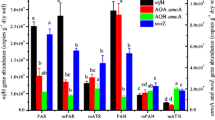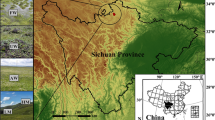Abstract
Ebinur Lake Wetland is an understudied desert wetland ecosystem, particularly regarding nitrogen cycling. This study aimed to ascertain the diversity and richness of nitrogen-fixing bacterial communities in the Ebinur Lake Wetland. The diversity of the nitrogen-fixing bacteria community of nifH genes from the rhizosphere and non-rhizosphere soils of four plants in different seasons were examined using Illumina HiSeq PE250 high-throughput sequencing technology. The correlation between soil environmental factors and diversity and richness of nitrogen-fixing bacteria was studied using the redundancy analysis (RDA). The results showed that the diversity of nitrogen-fixing bacteria in the rhizosphere soil of the constructive plants was higher than that in the non-rhizosphere soil; also, the diversity in July was higher than that in October and April. Geobacter, Pseudomonas and Bradyrhizobium were the dominant common bacteria in different samples of Ebinur Lake Wetland. The RDA showed that the total nitrogen, available potassium and available phosphoruswere significantly correlated with the diversity and richness of nitrogen-fixing bacteria. The diversity and community structure of nitrogen-fixing bacteria in soil samples also changed over time. The community structures of nitrogen-fixing bacteria in the rhizosphere and non-rhizosphere soils of the four plants were not the same during the same period. The correlation between soil environmental factors and the community structure and abundance of nitrogen-fixing bacteria can provide data basis and theoretical support for the degradation and restoration of Ebinur Lake Wetland.









Similar content being viewed by others
References
Aust WM, Mader SF, Mitchell LJ, Lea R (1990) An approach to the inventory of forested wetlands for timber-harvesting impact assessment. For Ecol Manage 33:215–225
Canfield DE, Glazer AN, Falkowski PG (2010) The evolution and future of Earth’s nitrogen cycle. Science 330:192–196
Chen SN, Gu J, Fu QX, Sun W, Qian X, Gao H, Qin QJ (2012) Effects of inoculating azotobacter on soil enzyme activities and bacterial community functional diversity in the rhizosphere of maize (Zea mays L.). Plant Nutr Fert Sci 18:444–450
Chen MH, Sheu SY, James EK, Young CC, Chen WM (2013) Azoarcusolearius sp. Nov., a nitrogen-fixing bacterium isolated from oil-contaminated soil. Int J Syst Evol Microbiol 63:3755–3761
Chen XP, Yang JN, Zhu XE, Liang X, Lei YR, He CQ (2016) N-fixing trees in wetland restoration plantings: effects on nitrogensupply and soil microbial communities. Environ Sci Pollut Res Int 23:24749–24757
Chen J, Shen WJ, Xu H, Li YD, Luo TS (2019) The composition of nitrogen-fixing microorganisms correlates with soil nitrogen content during reforestation: a comparison between legume and non-legume plantations. Front Microbiol 10:1–11
Hou HJ, Qin HL, Chen CL, Wei WX (2014) Research progress of the molecular ecology on microbiological processes in soil nitrogen cycling. Res Agric Modern 35:588–594
Ininbergs K, Bay G, Rasmussen U, Wardle DA, Nilsson MC (2011) Composition and diversity of nifH genes of nitrogen-fixing cyanobacteria associated with boreal forest feather mosses. New Phytol 192:507–517
John RC, Itah AY, Essien JP, Ikpe DI (2011) Fate of nitrogen-fixing bacteria in crude oil contaminated wetland ultisol. Bull Environ Contam Toxicol 87:343
Keeling AA, Cook JA, Wilcox A (1998) Effects of carbohydrate application on diazotroph populations and nitrogen availability in grass swards established in garden waste compost. Bioresour Technol 66:89–97
Lan HZ, Hu WG, Yang Y, He Y, Gao Y (2019) Environmental heterogeneity of the nitrogen-fixing microbial community structure and abundance in thand identification of sulfate-reducing bacteriae soil surrounding Halocnemum strobilaceum in Ebinur Lake wetland. Microbiol China 46:1597–1610
Li J, Chen ZL, Li XW (2015) Research on the quantity and diversity of nitrogen cycle microorganisms in Tibetan Wetland ecosystem. Tibet Sci Technol 22:70–72+78
Limmer C, Drake HL (1996) Non-symbiotic N2-fixation in acidic and pH-neutral forest soils: aerobic and anaerobic differentials. Soil Biol Biochem 28:177–183
Lu RK (2000) Analytical method of soil agricultural chemistry. Agricultural Science and Technology Press, Bei**g
Mason CE, Elemento O (2012) Faster sequencers, larger datasets, new challenges. Genome Biol 13:314–314
Neumann G, Romheld V (2003) Root-induced changes in the availability of nutrients in the rhizosphere. Chem Inform 34:617–649
Ospina-Betancourth C, Acharya K, Allen B, Entwistle J, Head IM, Sanabria J, Curtis TP (2020) Enrichment of nitrogen-fixing bacteria in a nitrogen-deficient wastewater treatment system. Environ Sci Technol 54:3539–3548
Oved T, Shaviv A, Goldrath T, Mandelbaum RT, Minz D (2001) Influence of effluent irrigation on community composition and function of ammonia-oxidizing bacteria in soil. Appl Environ Microbiol 67:3426
Rappé MS, Giovannoni SJ (2003) The uncultured microbial majority. Ann Rev Micro 57:369–394
Rejmankova E, Sirova D, Castle S, Barta J, Carpenter H (2018) Heterotrophic N2-fixation contributes to nitrogen economy of a common wetland sedge, Schoenoplectus californicus. PLoS ONE 13:e0195570
Santoro AE, Francis CA, De Sieyes NR, Boehm AB (2008) Shifts in the relative abundance of ammonia-oxidizing bacteria and archaea across physicochemical gradients in a subterranean estuary. Environ Microbiol 10:1068–1079
Sardinha M, Müller T, Schmeisky H, Joergensen RG (2003) Microbial performance in soils along a salinity gradient under acidic conditions. App Soil Ecol 23:237–244
Simon Z, Mtei K, Gessesse A, Ndakidemi PA (2014) Isolation and characterization of nitrogen fixing rhizobia from cultivated and uncultivated soils of northern Tanzania. Am J Plant Sci 5:4050
Tan ZY, Peng GX, Xu PZ, Ai SY, Tang SH, Zhang GX, Zeng FY (2009) Diversity and high nitrogenase activity of endophytic diazotrophs isolated from Oryza Rufipogon Griff. Chin Sci Bull 54:2839–2848
Terakado-Tonooka J, Ohwaki Y, Yamakawa H, Tanaka F, Yoneyama T, Fujihara S (2008) Expressed nifH genes of endophytic bacteria detected in field-grown sweet potatoes (Ipomoea batatas L.). Microbes Environ 23:89–93
Thajudeen J, Yousuf J, Veetil VP, Varghese S, Singh A, Abdulla MH (2017) Nitrogen fixing bacterial diversity in a tropical estuarine sediments. World J Microbiol Biotechnol 33:41
Truu M, Juhanson J, Truu J (2009) Microbial biomass, activity and community composition in constructed wetlands. Sci Total Environ 407:3958–3971
Vitousek PM et al (1997) Human alteration of the global nitrogen cycle: sources and consequences. Ecol Appl 7:737–750
Wakelin SA, Gupta VVSR, Forrester ST (2010) Regional and local factors affecting diversity, abundance and activity of free-living, N2-fixing bacteria in Australian agricultural soils. Pedobiologia 53:391–399
Wang XF (2020) Effects of biological nitrogen fixation on soil environment and vegetation development in bare land of glacier retreat. MS thesis, University of Chinese Academy of Sciences
Wang YQ, He JZ, Zhao XL, Zhang HY, Deng F, Jia XY, Liu C (2009) Comparison of salt-tolerance and drought-tolerance of two desert pants (Karelinia caspica and Suaeda turkestanica litw.) in Tarim. Genom Appl Biol 28:1128–1134
Wang HL, Zhang HG, Qin L, Ma HY, Lü GH (2012) The characteristics of the spatial distribution of soil organic matter and factors influencing it in Ebinur Lake Basin of **njiang Autonomous Region. China Acta Ecol Sin 32:4969–4980
Wang Y, Luo JF, Lin WT (2013) Isolation and identification of sulfate-reducing bacteria from Pearl River sediment. Mod Food Sci Technol 29:1586–1590
Wang J, Bao JT, Li XR, Liu YB (2016) Molecular ecology of nifH genes and transcripts along a chronosequence in revegetated areas of the Tengger Desert. Microb Ecol 71:150–163
Wardle DA, Bardgett RD, Klironomos JN, Setälä H, Van Der Putten WH, Wall DH (2004) Ecological linkages between aboveground and belowground biota. Science 304:1629–1633
Wolińska A, Kuźniar A, Zielenkiewicz U, Banach A, Izak D, Stępniewska Z, Błaszczyk M (2017) Metagenomic analysis of some potential nitrogen-fixing bacteria in arable soils at different formation processes. Microb Ecol 73:162–176
**ang XM, **a SC, Li YS, Sun XY (2004) Microorganism features of typha latifolia and Phragmites australis at rhizosphere Environ. Prot Sci 30:35–38
**ng HX (2006) Isolation and identification of endophytic nitrogen fixation in sugarcane and growth characteristics. MS thesis, Guangxi University
Yang D, Hu W, Chen D, Dong Y, Wang Y, Han J (2013) Correlation analysis between nitrogen-fixing bacteria number and organic matter, microbial biomass C N in different soil depth and seasons of Ebinur Lake Wetland Southwest China. J Agri Sci 26:2417–2421
Yeager CM, Kuske CR, Carney TD, Johnson SL, Ticknor LO, Belnap J (2012) Response of biological soil crust diazotrophs to season, altered summer precipitation, and year-round increased temperature in an arid grassland of the Colorado Plateau, USA. Front Microbiol 3:358
Young JPW (1992) Phylogenetic Classification of Nitrogen-Fixing Organisms. Biol Nitrogen Fixation 1544:43–86
Yu Y, Wang H, Liu J, Wang Q, Shen TL, Guo WH, Wang RQ (2012) Shifts in microbial community function and structure along the successional gradient of coastal wetlands in Yellow River Estuary. Eur J Soil Biol 49:12–21
Zhang F, Shen J, Li L, Liu X (2004) An overview of rhizosphere processes related with plant nutrition in major crop** systems in China. Plant Soil 260:89–99
Zhang YG, Li DQ, Wang HM, **ao QM, Liu XD (2006) Molecular diversity of nitrogen-fixing bacteria from the Tibetan Plateau, China. FEMS Microbiol Lett 260:134–142
Zhang YG, Wang HM, Li DQ, **ao QM, Liu XD (2005) The community and structure of nitrogen-fixing microorganism in Sanjiangyuan natural reserve. Acta Ecol Sin 45:420-425
Zhao YJ, Liu B, Zhang WG, Hu CW, An SQ (2010) Effects of plant and influent C:N:P ratio on microbial diversity in pilot-scale constructed wetlands. Ecol Eng 36:441–449
Zou YK et al (2011) Effects of different land use patterns on NifH genetic diversity of soil nitrogen-fixing microbial communities in Leymus Chinensis Steppe. Acta Ecol Sin 31:150–156
Acknowledgements
This work was supported by the National Natural Science Foundation of China [Grant number 31560040]. We declare that we have no financial and personal relationships with other people or organizations that can inappropriately influence our work.
Author information
Authors and Affiliations
Corresponding author
Additional information
Communicated by Erko Stackebrandt.
Publisher's Note
Springer Nature remains neutral with regard to jurisdictional claims in published maps and institutional affiliations.
Supplementary Information
Below is the link to the electronic supplementary material.
Rights and permissions
About this article
Cite this article
Zhang, X., Hu, W., **, X. et al. Diversity of soil nitrogen-fixing bacteria in the rhizosphere and non-rhizophere soils of Ebinur Lake Wetland. Arch Microbiol 203, 3919–3932 (2021). https://doi.org/10.1007/s00203-021-02363-x
Received:
Revised:
Accepted:
Published:
Issue Date:
DOI: https://doi.org/10.1007/s00203-021-02363-x




